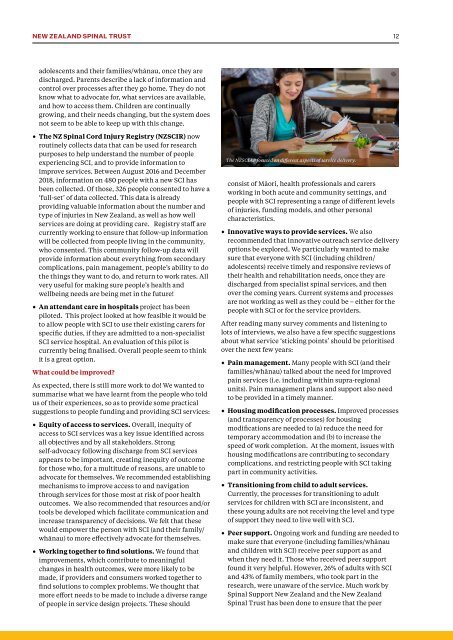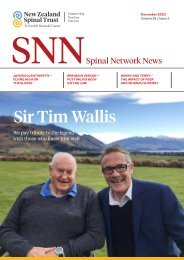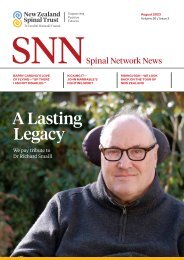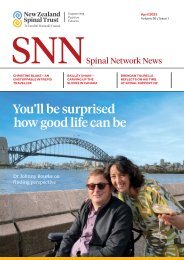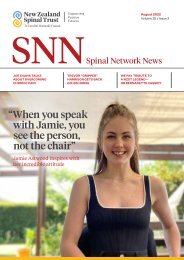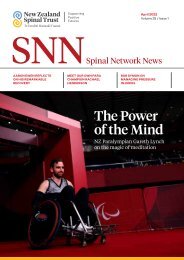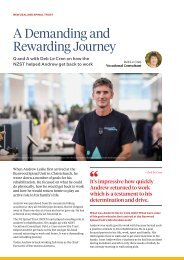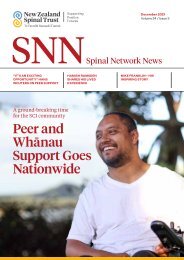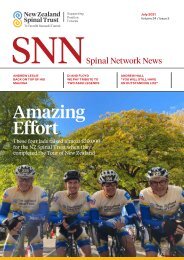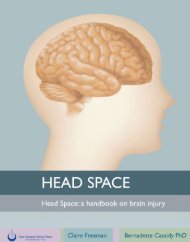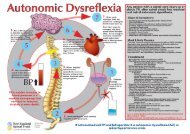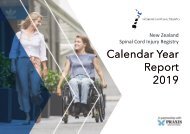SNN_August 2020 Issue FA_low res
Create successful ePaper yourself
Turn your PDF publications into a flip-book with our unique Google optimized e-Paper software.
NEW ZEALAND SPINAL TRUST 12<br />
adolescents and their families/whānau, once they are<br />
discharged. Parents describe a lack of information and<br />
control over processes after they go home. They do not<br />
know what to advocate for, what services are available,<br />
and how to access them. Children are continually<br />
growing, and their needs changing, but the system does<br />
not seem to be able to keep up with this change.<br />
• The NZ Spinal Cord Injury Registry (NZSCIR) now<br />
routinely collects data that can be used for <strong>res</strong>earch<br />
purposes to help understand the number of people<br />
experiencing SCI, and to provide information to<br />
improve services. Between <strong>August</strong> 2016 and December<br />
2018, information on 480 people with a new SCI has<br />
been collected. Of those, 326 people consented to have a<br />
‘full-set’ of data collected. This data is already<br />
providing valuable information about the number and<br />
type of injuries in New Zealand, as well as how well<br />
services are doing at providing care. Registry staff are<br />
currently working to ensure that fol<strong>low</strong>-up information<br />
will be collected from people living in the community,<br />
who consented. This community fol<strong>low</strong>-up data will<br />
provide information about everything from secondary<br />
complications, pain management, people’s ability to do<br />
the things they want to do, and return to work rates. All<br />
very useful for making sure people’s health and<br />
wellbeing needs are being met in the future!<br />
• An attendant care in hospitals project has been<br />
piloted. This project looked at how feasible it would be<br />
to al<strong>low</strong> people with SCI to use their existing carers for<br />
specific duties, if they are admitted to a non-specialist<br />
SCI service hospital. An evaluation of this pilot is<br />
currently being finalised. Overall people seem to think<br />
it is a great option.<br />
What could be improved?<br />
As expected, there is still more work to do! We wanted to<br />
summarise what we have learnt from the people who told<br />
us of their experiences, so as to provide some practical<br />
suggestions to people funding and providing SCI services:<br />
• Equity of access to services. Overall, inequity of<br />
access to SCI services was a key issue identified across<br />
all objectives and by all stakeholders. Strong<br />
self-advocacy fol<strong>low</strong>ing discharge from SCI services<br />
appears to be important, creating inequity of outcome<br />
for those who, for a multitude of reasons, are unable to<br />
advocate for themselves. We recommended establishing<br />
mechanisms to improve access to and navigation<br />
through services for those most at risk of poor health<br />
outcomes. We also recommended that <strong>res</strong>ources and/or<br />
tools be developed which facilitate communication and<br />
increase transparency of decisions. We felt that these<br />
would empower the person with SCI (and their family/<br />
whānau) to more effectively advocate for themselves.<br />
• Working together to find solutions. We found that<br />
improvements, which contribute to meaningful<br />
changes in health outcomes, were more likely to be<br />
made, if providers and consumers worked together to<br />
find solutions to complex problems. We thought that<br />
more effort needs to be made to include a diverse range<br />
of people in service design projects. These should<br />
The NZSCIAP focused on different aspects of service delivery.<br />
consist of Māori, health professionals and carers<br />
working in both acute and community settings, and<br />
people with SCI rep<strong>res</strong>enting a range of different levels<br />
of injuries, funding models, and other personal<br />
characteristics.<br />
• Innovative ways to provide services. We also<br />
recommended that innovative outreach service delivery<br />
options be explored. We particularly wanted to make<br />
sure that everyone with SCI (including children/<br />
adolescents) receive timely and <strong>res</strong>ponsive reviews of<br />
their health and rehabilitation needs, once they are<br />
discharged from specialist spinal services, and then<br />
over the coming years. Current systems and processes<br />
are not working as well as they could be – either for the<br />
people with SCI or for the service providers.<br />
After reading many survey comments and listening to<br />
lots of interviews, we also have a few specific suggestions<br />
about what service ‘sticking points’ should be prioritised<br />
over the next few years:<br />
• Pain management. Many people with SCI (and their<br />
families/whānau) talked about the need for improved<br />
pain services (i.e. including within supra-regional<br />
units). Pain management plans and support also need<br />
to be provided in a timely manner.<br />
• Housing modification processes. Improved processes<br />
(and transparency of processes) for housing<br />
modifications are needed to (a) reduce the need for<br />
temporary accommodation and (b) to increase the<br />
speed of work completion. At the moment, issues with<br />
housing modifications are contributing to secondary<br />
complications, and <strong>res</strong>tricting people with SCI taking<br />
part in community activities.<br />
• Transitioning from child to adult services.<br />
Currently, the processes for transitioning to adult<br />
services for children with SCI are inconsistent, and<br />
these young adults are not receiving the level and type<br />
of support they need to live well with SCI.<br />
• Peer support. Ongoing work and funding are needed to<br />
make sure that everyone (including families/whānau<br />
and children with SCI) receive peer support as and<br />
when they need it. Those who received peer support<br />
found it very helpful. However, 26% of adults with SCI<br />
and 43% of family members, who took part in the<br />
<strong>res</strong>earch, were unaware of the service. Much work by<br />
Spinal Support New Zealand and the New Zealand<br />
Spinal Trust has been done to ensure that the peer


